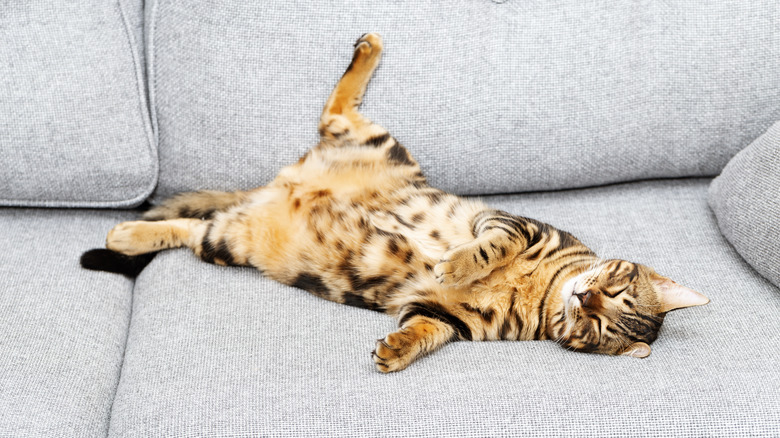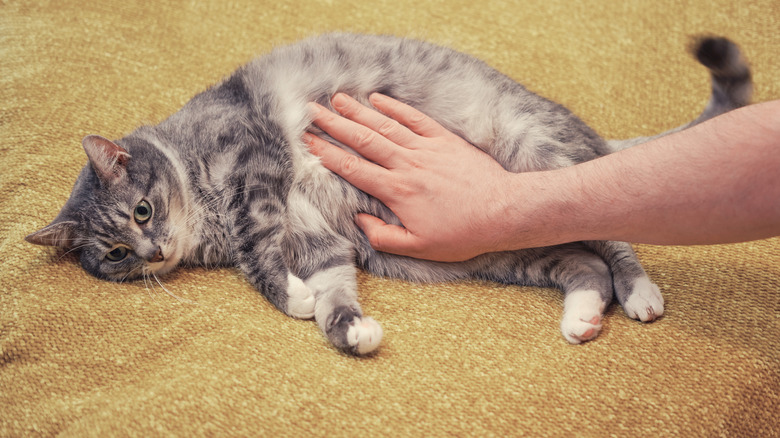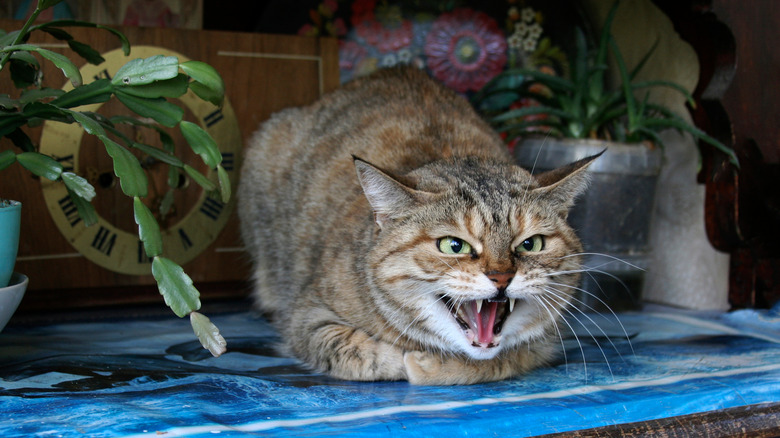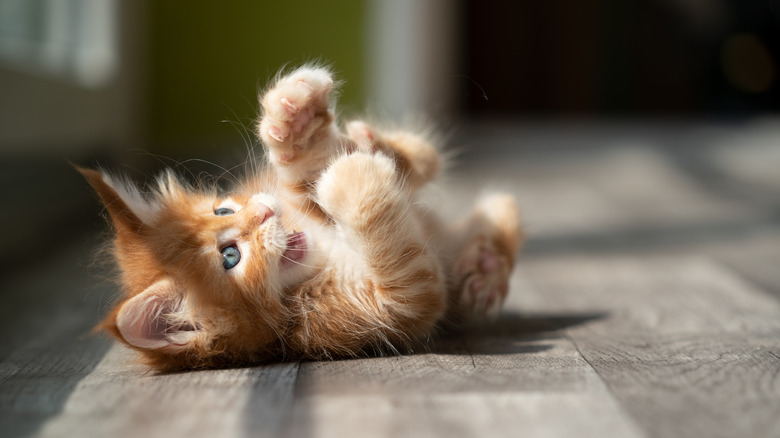
While our household cats might seem like simple creatures, as it turns out, there’s a lot about them that we don’t understand. One of the biggest shockers when it comes to the complexity of our felines is that they make nearly 100 distinct sounds that all have unique meanings, despite many of them sounding indistinguishable to humans. Some reports suggest that some of the noises they make might even be the result of mimicking the sounds of human babies in order to get attention (via Sophisticat). In addition, did you know that a cat’s whiskers are actually intricate sensory tools that can determine a cat’s mood? Whether house cats or cats in the wild, whiskers are what help these animals hunt so effectively, as they help measure distance, detect prey, and sense approaching danger (via Purina).
The cool cat facts are truly endless. But one of the most complicated body languages from our cats is actually when they lie on their backs. Experts suggest that this simple act can mean lots of different things.
An exposed belly is not an invitation to pet it

Cats’ bellies are especially vulnerable areas of their bodies, and they won’t just show them to anyone. If you’re lucky enough to be around a cat that rolls onto its back to show its belly to you, this is often a good sign. According to experts, when a cat shows you its belly, it’s a sign of happiness, calmness, and most importantly, of trust (via Your Cat). That being said, this is not necessarily an invitation to pet your cat’s belly.
While a dog rolling onto its back is most likely a sign for you to rough house with it and give that dog a good belly scratch, it’s quite the opposite with cats. According to Lena Provoost, an animal behaviorist at the University of Pennsylvania School of Veterinary Medicine, the hair follicles on the belly and tail area of cats are hypersensitive, which means they won’t feel comfortable if you touch them there and they might even get anxious as a result (via Meowingtons).
Live Science recommends petting your cat around its facial glands, so the base of its ears, under its chin, and around its cheeks. Otherwise, if you’re not sure where to touch a cat, let it come to you. Cats love head bumping, according to Pam Johnson-Bennett, a cat behavior expert. She says that cats head bump as a way to “exchange scents” so that everyone in their environment smells like them. “They’re saying ‘I love you. You’re so wonderful but you’re also a little stinky. Let’s get you smelling like us,'” Johnson explained to PetMD.
A cat might show you its belly when they're feeling aggressive

Another reason that a cat might lie on its back is for the exact opposite of the first reason — because they’re upset. While they might look adorable with their belly up to the sky, beware: they might be getting into this position in order to attack. While on their back, they can use all four feet (with those sharp claws) to bite, kick, or scratch you. But don’t take offence — this body language could also indicate that your cat is just trying to be playful, which can often be mistaken for aggression (via Pleasant Plains Animal Hospital).
Wondering how to tell aggression and playfulness apart? There are a few signs that will determine the difference. If your cat is in the position in order to attack, it will typically also be paired with their ears being flattened all the way against their heads, and they might even have dilated eyes or will begin growling or hissing (via Cuteness). Either way, in this situation, your cat is most likely not looking to cuddle, but to use those claws — so keep an eye out.
Here are some other reasons a cat might expose their belly to you

Cats often expose their bellies in order to greet you. Just like dogs, cats can feel separation anxiety and will be overjoyed for you to return. This is a sign that your cat trusts and loves you — so you’re probably a great cat parent! This behavior will also often be paired with head bumping, circling around your feet, or meowing, per Senior Cat Wellness.
A cat might also expose their belly through the act of rolling on the ground, which is another sign of a happy feline. According to AnimalWised, this is another way that cats like to mark their territory and to spread their scent. This act will emit pheromones which is an effective way of protecting their territory and claiming an area as their own. This behavior isn’t only seen with domestic cats, but with big cats like tigers in the wild, as well.
Some reports also suggest that this rolling behavior is actually a way for the cat to protect its digestive system. According to The Spruce Pets, by rolling around on the ground, the cat’s coat will become covered in bacteria, which they will then lick off of themselves and ingest. This whole process will ultimately aid in their digestion by giving them a healthy gastrointestinal tract.
Source: Read Full Article
